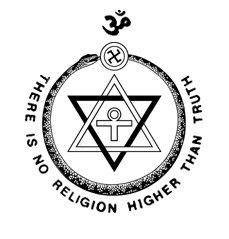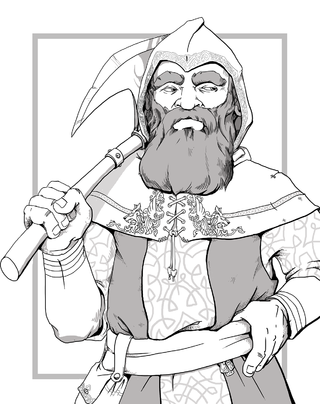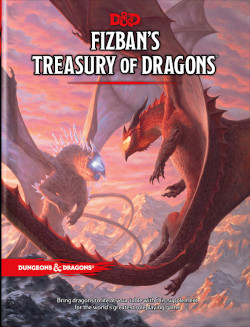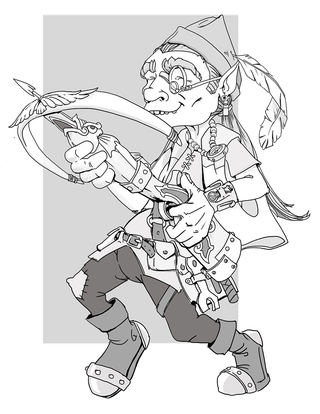Subrace may refer to:
- Subrace, a taxonomic rank below race (biology)
- Subrace, a particular variety of a race (fantasy)
Subrace may refer to:
The Dinaric race, also known as the Adriatic race, were psuedoscientific terms used by certain physical anthropologists in the early to mid-20th century to describe the perceived predominant phenotype of the contemporary ethnic groups of southeast Europe. According to the discredited theories of physical anthropologist Carleton Coon, the Dinaric race was most commonly found among the populations in the Balkans and Carpathians, such as Montenegrins, Serbs, Bosniaks, Croats, Ghegs, Slovaks, Romanians, Hungarians, Western Ukrainians, and Southern Poles. Additionally, in Northern Europe, the South Germans are also identified as having Dinaric characteristics.

Jan Czekanowski was a Polish anthropologist, statistician, ethnographer, traveller, and linguist. He was one of the first persons to use quantitative methods in linguistics.

Root races are concepts in the esoteric cosmology of Theosophy. As described in Helena Petrovna Blavatsky's book The Secret Doctrine (1888), these races correspond to stages of human evolution, and existed mainly on now-lost continents. Blavatsky's model was developed by later theosophists, most notably William Scott-Elliot in The Story of Atlantis (1896) and The Lost Lemuria (1904). Annie Besant further developed the model in Man: Whence, How and Whither (1913). Both Besant and Scott-Elliot relied on information from Charles Webster Leadbeater obtained by "astral clairvoyance". Further elaboration was provided by Rudolf Steiner in Atlantis and Lemuria (1904). Rudolf Steiner, and subsequent theosophist authors, have called the time periods associated with these races Epochs.
The Nordic race is an obsolete racial concept which originated in 19th-century anthropology. It was once considered a race or one of the putative sub-races into which some late-19th to mid-20th century anthropologists divided the Caucasian race, claiming that its ancestral homelands were Northwestern and Northern Europe, particularly to populations such as Anglo-Saxons, Germanic peoples, Balts, Baltic Finns, Northern French, and certain Celts, Slavs and Ghegs. The supposed physical traits of the Nordics included light eyes, light skin, tall stature, and dolichocephalic skull; their psychological traits were deemed to be truthfulness, equitability, a competitive spirit, naivete, reservedness, and individualism. In the early 20th century, the belief that the Nordic race constituted the superior branch of the Caucasian race gave rise to the ideology of Nordicism.

A dwarf, in the Dungeons & Dragons (D&D) fantasy roleplaying game, is a humanoid race, one of the primary races available for player characters. The idea for the D&D dwarf comes from the dwarves of European mythologies and J. R. R. Tolkien's novel The Lord of the Rings (1954–1955), and has been used in D&D and its predecessor Chainmail since the early 1970s. Variations from the standard dwarf archetype of a short and stout demihuman are commonly called subraces, of which there are more than a dozen across many different rule sets and campaign settings.

Character creation is the process of defining a player character in a role-playing game. The result of character creation is a direct characterization that is recorded on a character sheet. This may include a representation of the character's physical, mental, psychological, and social attributes and skills in terms of the specific game's mechanics. It may also include informal descriptions of the character's physical appearance, personality, personal back-story ("background"), and possessions. Games with a fantasy setting may include traits such as race, class, or species. Character creation is the first step taken by the players in preparation for a game.

The elf is a humanoid race in the Dungeons & Dragons fantasy role-playing game, one of the primary races available for player characters, and play a central role in the narratives of many setting worlds of the game. Elves are described as renowned for their grace and mastery of magic and weapons such as the bow and sword. Becoming physically mature by the age of 25 and emotionally mature at around 125, they are also famously long-lived, capable of living more than half a millennium and remaining physically youthful. Possessed of innate beauty and easy gracefulness, they are viewed as both wondrous and haughty by other races in-universe; however, their natural detachment is seen by some as introversion or xenophobia. They were usually portrayed as antagonistic towards dwarves.
Sword World RPG is a Japanese tabletop role-playing game created by Group SNE. 10 million copies of the related books including rulebooks, novels and replays have been sold. The game was first published in 1989; the updated edition, known as the "Sword World 2.0", was published in 2008; the current edition "Sword World 2.5" was published in 2018.
Derro may refer to:

Races of Stone is an optional sourcebook for the 3.5 edition of the Dungeons & Dragons fantasy role-playing game.
Dark elf may refer to:
Various attempts have been made, under the British Raj and since, to classify the population of India according to a racial typology. After independence, in pursuance of the government's policy to discourage distinctions between communities based on race, the 1951 Census of India did away with racial classifications. Today, the national Census of independent India does not recognise any racial groups in India.
Wood elf is a generic term for an elf that lives in wooded areas such as forests.
The Irano-Afghan race or Iranid race is an obsolete racial classification of human beings based on a now-disproven theory of biological race. Some anthropologists of the 20th century classified the populations native to the Iranian plateau as belonging to this race, which was usually seen as a subrace of the Caucasian race or the Mediterranean racial subtype of that race, depending on the authority consulted.
The half-elf is a player character race featured in Dungeons & Dragons and related material.

The Complete Book of Dwarves is a supplemental rulebook for the 2nd edition of the Advanced Dungeons & Dragons fantasy role-playing game, published in 1991 by TSR, Inc. It contains a variety of information useful to playing dwarf characters in the game, including information on strongholds, dwarven subraces, character "kits", role-playing, mining, and more. The book was later reprinted in November 1993, with a slightly different cover.
The Pamirid race, also Pamir-Fergana race, is the most Eastern subrace of the Europid race, a racial category is now considered to be obsolete. It was said to be common in Central Asia, represented mostly by the Pamiris, Tajiks, Uyghurs and Uzbeks. Characterized by brachycephalic skull, dark hair, white skin, narrow protruding nose and fairly strong development of the tertiary hair cover.

Princes of the Apocalypse is an adventure module for the 5th edition of the Dungeons & Dragons fantasy role-playing game.

Fizban's Treasury of Dragons is sourcebook that focuses on dragons in the 5th edition of the Dungeons & Dragons fantasy role-playing game and was published October 26, 2021. The book adds a variety of draconic themed options for both players and Dungeon Masters.

In the Dungeons & Dragons fantasy role-playing game, gnomes are one of the core races available for play as player characters. Some speculate that they are closely related to dwarves; however, gnomes are smaller and more tolerant of other races, nature, and magic. Depending on the setting and subrace, they are often skilled with illusion magic or engineering. Gnomes are small humanoids, standing 3–3.5 feet (91–107 cm) tall.